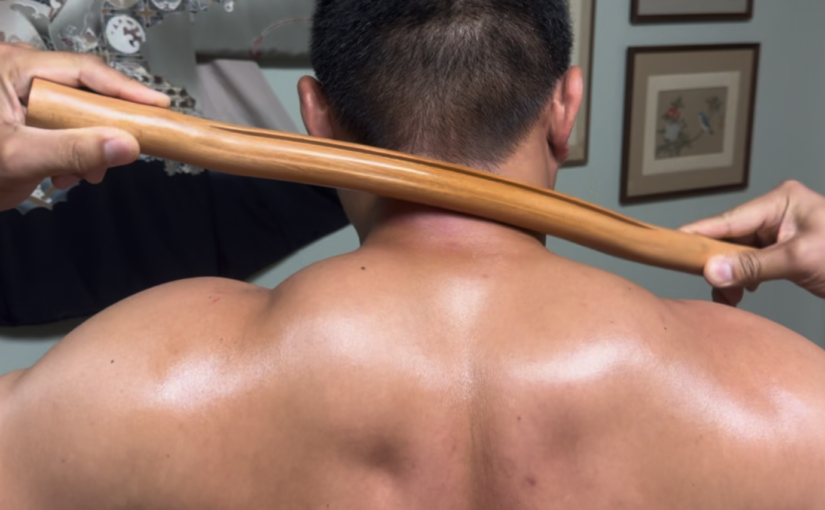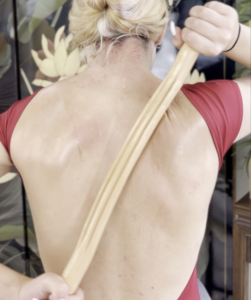Jul 12, 2024Using Gua Sha to enhance athletic performance
Tom Brady was able to play professional football until he was 45. One of his training secrets is to sculpt his body using pliability and flexibility. When he was 26, he had an elbow injury that may have required surgery.
However, one of his teammates urged him to be treated by a personal trainer brought in from California once a month. After a weekend of treatment, Tom Brady’s elbow felt much better, and he decided to try this new style of bodywork. As a result, he never needed surgery on his elbow. He also had fewer injuries than most players.
 Our muscles and tendons require daily attention. Our body produces new cells while old ones die, and it must clean up the remains of dead cells. However, when our muscles and tendons are too tight, the body can’t do its job correctly, and the dead cells remain in the muscle tissue, causing pain and discomfort. In ancient China, people discovered that scraping the skin could help loosen the muscles and tendons, making them more pliable. This technique, known as Gua Sha, helps release the debris that causes pain and other problems.
Our muscles and tendons require daily attention. Our body produces new cells while old ones die, and it must clean up the remains of dead cells. However, when our muscles and tendons are too tight, the body can’t do its job correctly, and the dead cells remain in the muscle tissue, causing pain and discomfort. In ancient China, people discovered that scraping the skin could help loosen the muscles and tendons, making them more pliable. This technique, known as Gua Sha, helps release the debris that causes pain and other problems.
In Chinese, “Gua” means “scraping,” while “Sha” refers to “small red dots on the skin.” In English, this is known as Petechiae. Gua Sha uses a scraping tool to loosen muscle fibers and fascia adhesions. This improves circulation and removes toxins from the body, relieving pain. This deep-tissue massage done daily can be done quickly and with minimal discomfort, as a larger area is treated all at once.
Tom Brady has a 20-minute massage before and after every workout. On game days, he’d have an hour-long massage before and after the games. Only some people can afford to have a professional masseuse work on them for this amount of time. Therefore, establishing a routine performed every morning after the athlete gets out of the shower can help detoxify their bodies and loosen up muscle knots and fascia adhesions, creating pliability.
 Gua Sha/Scrapping Massage is a type of deep tissue massage that is quick and simple. This style of Asian massage has not been widely used in America due to the red marks it can leave behind at times, known as petechiae. However, when these marks appear, they indicate where the fascia adhesions are located. The effects of the red marks usually disappear within two to three days. Once the area is free of knots in the muscles and fascia adhesions, circulation is restored to the nerves, and pain subsides. Gua Sha/Scrapping Massage can be performed using a small handheld tool, which can cause pain in the hands of the person performing the massage.
Gua Sha/Scrapping Massage is a type of deep tissue massage that is quick and simple. This style of Asian massage has not been widely used in America due to the red marks it can leave behind at times, known as petechiae. However, when these marks appear, they indicate where the fascia adhesions are located. The effects of the red marks usually disappear within two to three days. Once the area is free of knots in the muscles and fascia adhesions, circulation is restored to the nerves, and pain subsides. Gua Sha/Scrapping Massage can be performed using a small handheld tool, which can cause pain in the hands of the person performing the massage.
To make the process more comfortable and practical, it is recommended to use a specially designed Gua Sha/Scrapping Massage stick.
Here are links to training videos on how to practice Gua Sha/Scrapping Massage
•https://www.youtube.com/@drkatherineteisingerdaom4348
• https://www.ply-u-flex.com/blog
The science behind Gua Sha/Scrapping Massage was not thoroughly understood until 2007 when a group of German vascular researchers discovered the existence of the facial system. They did so by inserting a camera into living tissue to observe how veins moved. Thanks to this discovery, we better understand the mechanisms that cause pain in the human body. As a result, we are also learning how to improve our methods of treating the body to alleviate pain and discomfort.
In understanding how the human body functions, it’s important to consider fascia. This aspect was not extensively taught in school due to the lack of technology that hindered a thorough understanding of this tissue. Fascia, previously referred to as connective tissue, plays a crucial role in holding everything together, including muscles, ligaments, tendons, and bones, and should not be overlooked. Unlike other body parts, fascia undergoes significant changes after death, which previously posed challenges for study. However, now that we have a better understanding of it, we can observe that scraping the skin pulls on the fascia, much like how the swaying of a tree in the wind affects the roots and consequently impacts the tissue down to the bone.
» ALSO SEE: Study—Higher training volume leads to increased size, not strength
Studying fascia has also taught us that proper hydration is crucial in preventing muscle cramps due to the high water content of fascia. Keeping the body hydrated and using techniques like scraping can help reduce muscle cramps.
Minor injuries, such as sprains, strains, tears, and bruising, can occur to body tissues when they are not adequately hydrated and warmed up. That’s why we recommend stretching and a scraping massage every morning after a shower. This can help reduce pain and increase flexibility and pliability in the fascia, muscles, and tendons. It prevents injuries and keeps your athletes healthy. For more information, visit https://www.ply-u-flex.com.


